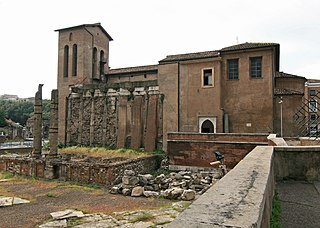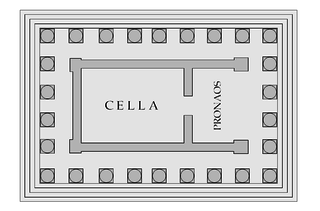Bona Dea was a goddess in ancient Roman religion. She was associated with chastity and fertility among married Roman women, healing, and the protection of the state and people of Rome. According to Roman literary sources, she was brought from Magna Graecia at some time during the early or middle Republic, and was given her own state cult on the Aventine Hill.

The Temple of Caesar or Temple of Divus Iulius, also known as Temple of the Deified Julius Caesar, delubrum, heroon or Temple of the Comet Star, is an ancient structure in the Roman Forum of Rome, Italy, located near the Regia and the Temple of Vesta.

Tiber Island is the only river island in the part of the Tiber which runs through Rome. Tiber Island is located in the southern bend of the Tiber.

The Temple of Vesta, or the aedes, is an ancient edifice in Rome, Italy. It is located in the Roman Forum near the Regia and the House of the Vestal Virgins. The Temple of Vesta housed Vesta's holy fire, which was a symbol of Rome's safety and prosperity. The temple has a circular footprint, making it a tholos.

The Temple of Hercules Victor or Hercules Olivarius is a Roman temple in Piazza Bocca della Verità, the former Forum Boarium, in Rome, Italy. It is a tholos, a round temple of Greek 'peripteral' design completely surrounded by a colonnade. This layout caused it to be mistaken for a temple of Vesta until it was correctly identified by Napoleon's Prefect of Rome, Camille de Tournon.

The Temple of Concord in the ancient city of Rome refers to a series of shrines or temples dedicated to the Roman goddess Concordia, and erected at the western end of the Roman Forum. The earliest temple is believed to have been vowed by Marcus Furius Camillus in 367 BC, but it may not have been built until 218 BC by L. Manlius. The temple was rebuilt in 121 BC, and again by the future emperor Tiberius between 7 BC and AD 10.

The Temple of Janus at the Forum Holitorium was a Roman temple dedicated to the god Janus, located between the Capitoline Hill and the Tiber River near the Circus Flaminius in the southern Campus Martius. The temple was built during the First Punic War, after the Temple of Janus in the Roman Forum.

The Temple of Jupiter Stator, also known to the ancient Romans as the Temple of Jove Metellina and Metellus's Temple, was a temple dedicated to the Roman god Jupiter Stator. It was located beside the Temple of Juno Regina in the Porticus Octaviae in the southern Campus Martius before its destruction in the AD 64 Great Fire of Rome.

The Temple of Venus Erycina was a temple on the Capitoline Hill in Ancient Rome dedicated to Venus Erycina. This was an aspect of the goddess Venus. Later this temple was probably called the Temple of the Capitoline Venus. There was another temple with the same name in Rome, the Temple of Venus Erycina.

The Temple of Juno Moneta was an ancient Roman temple that stood on the Arx or the citadel on the Capitoline Hill overlooking the Roman Forum. Located at the center of the city of Rome, it was next to the place where Roman coins were first minted, and probably stored the metal and coins involved in this process, thereby initiating the ancient practice of associating mints with temples. In addition, it was the place where the books of the magistrates were deposited.
The Temple of Juno Lucina was a Roman temple dedicated to Juno Lucina on the Esquiline Hill in Rome. It was dedicated on 1 March 375 BC, the festival of the Matronalia. Before its construction, the cult of Juno Lucina occurred in a sacred grove or lucus on the site - Varro dates the cult's origin to Titus Tatius, king of the Sabines. It was struck by lightning in 190 BC, damaging the tympanum and doorway. In 41 BC the quaestor Quintus Pedius built or rebuilt a wall possibly dating back to the sacred grove. It was still operational in the imperial period, as attested to in inscriptions.

The Temple of Fides was a minor temple on the Capitoline Hill in Rome. It was dedicated to Fides, the goddess of good faith, who was patron of diplomatic relations.
The Temple of Fortuna Equestris was a temple dedicated to the goddess Fortuna in ancient Rome. Its precise location is unknown, though Vitruvius states it stood near the Theatre of Pompey. No evidence of it remains after 22 AD, meaning it was probably lost in the fire of 21 AD, which also damaged the Theatre of Pompey.

The Temple of Hercules Musarum was a Roman temple dedicated to Hercules Musarum located near the Circus Flaminius in the southern Campus Martius in ancient Rome.

The Temple of Juno Regina was a temple dedicated to the Roman goddess Juno Regina located near the Circus Flaminius in the southern Campus Martius of ancient Rome. It was solemnly vowed by the consul Marcus Aemilius Lepidus in 187 BC during his final battle against the Liguri and was consecrated and opened on 23 December 179 BC, while he was serving as censor. It was linked by a portico to a temple of Fortuna, possibly the Temple of Fortuna Equestris, and later joined by a temple of Jupiter Stator. Both temples were surrounded by the Portico of Metellus. The portico and both temples were rebuilt by Augustus as the Porticus Octaviae sometime after 27 BC.

The Temple of Mars was a temple built on the campus Martius in Rome in the 2nd century BC, near the Circus Flaminius, dedicated to Mars.

The Temple of Neptune was an ancient Roman temple dedicated to Neptune on the Campus Martius near the Circus Flaminius in Rome.
The Temple of Luna was a temple on the Aventine Hill in Rome, dedicated to Luna, the moon goddess. Its dedication was celebrated on 31 March.
The Temple of Honor and Virtue was a temple in Regio I of ancient Rome dedicated to Virtus and Honos. No remains survive. It is the first entry for Regio I in the regional catalogues and was sited just outside the porta Capena, probably on the northern side of the via Appia. In front of it was the Ara Fortuna Redux.

The Temple of Mercury was a sanctuary in Ancient Rome on the Aventine Hill, which was dedicated to god Mercury. The temple was founded in 495 BC. It was one of the oldest temples in Rome. It is known to have still existed in the 3rd century. If in use into the 4th century, it would have been closed during the persecution of pagans in the late Roman Empire.

















